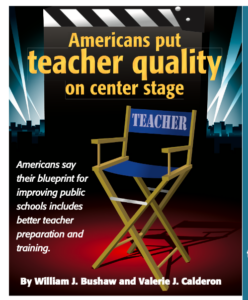
Are we looking at a classroom that is conducive to learning, or the delivery system for Competency-Based Education?
At one point in time, many of us saw Common Core as the Trojan Horse sent to destroy public education. But buried deep within its belly is CBE — Competency-Based Education. It is outcome-based education reform by another name —in another form. Just the same, it stinks of decay and ruin. No, the stench is worse.
Read on as my guest, a parent, explains the problems with standards-based assessments and the fallacy behind the label “competency-based education.” The following Facebook comment was spurred by an article about standards-based grading.
#####
In the real world, subjective assessment varies from person to person, group to group. Book and movie critics, for instance, vary widely as do reviews of plays and performances. Conversely, the correct answers to calculus and physics problems are the same regardless of the “assessor.”
For subjective subjects, a simple grading rubric for assignments used for the past 100 years or more allows the student to understand the keys to success for that assignment and to meet stated requirements. This is an important skill to master; in business one boss’s idea of success may not be consistent with another, and learning to flex your focus or style to please the assessor is a vital life skill.
The Standards-Based Grading article ignores this reality and instead hammers home the need for generic, uniform common core curriculum and regulated, dictated grading so as to strive for identical educational experiences.
Does this not take away the creative and unique ways individual educators can inspire and challenge and mold students according to their own God-given gifts for teaching?
Can we all not remember that special teacher in our schooling that changed us or “turned us on” to a topic that eventually brought us into a career path?
CBE (Competency-Based Education/Standards-Based) reduces the teacher to a sidelined coach, while the message is delivered by the standardized computer message or electronic text.
Since the days of Greek philosophers the concept of students being instructed and led through thought-provoking discussion to debate and challenge each other has been a successful model. Now suddenly, whether 100 or 2,800 years old this method is no longer valid? Because of iPads and Chromebooks? They are just tools, like wrenches or shovels or chisels or paint brushes; used to make a masterpiece.
The educational masterpiece itself is created by tapping the potential of students for creation of beautiful self-expression and thoughtful debate. Educators who groove on passing knowledge to students are crucial to the process. The educator/lecturer should never be just a sidelined coach that allows the computer to do the instruction.
God help us if we buy into this philosophy.
Further, God help us if we think rote memorization of fundamental math facts and spelling words are not needed and deny they are essential building blocks in the formative grades for advanced skill set proficiency in the latter grades. Writing an essay on a piece of literature requires actually being able to write (penmanship) and to create sentences with appropriate structure and grammar, and to be able to spell words as they flow from the mind quickly.
And, none of the dangers pediatricians are warning of today with regard to limiting device time because of negative impacts on neural network development are mentioned in the Standards-Based Grading article.
Parents: please read and educate yourselves on CBE. It is designed to make students “worker bees” that generation by generation are dumbed down, dependent on the Federal government and unable or unwilling to challenge the “Powers that Be.”
Let’s not forget Jefferson, Franklin and the Founding Fathers were able to gain independence from the England and halt imperial expansion with firepower yes, but overwhelmingly with the Power of the Pen.
Truly free people must have free thinkers, not cookie cutter worker bees that just want enough jingle for a pack of smokes and a Red Bull. The elitists would be happy to write-off most of our kids in this way …
Will you stand by and let them?
Or do you believe in the American dream as I do? That any child, from any home no matter how humble, no matter your skin color or your parental educational level or marital status …. ANY child can use the public education system to the fullest extent – extra credit if necessary – to be ANYTHING they want to be. And if they do, and if they make good choices, in three generations their entire family line can be pulled from poverty and be self-actualized. TRUTH: as long as we fight these ambitious, young, deceitful politicians that seek to suppress your child’s potential.
Are you going to let them do that to your child???? Your grandchildren? Our nation’s next generation?
Stay tuned folks, get informed, participate and show up to make your thoughts known. Let’s engage in thoughtful, respectful exchange of ideas, organize, and do something to CHANGE the overreach by the state and Federal government into our local education system. You can make a difference.
#####
Thank you to writer, Alyssa Collins (pen name). “Alyssa” is a full-time working mom and a conservative. She isn’t taking the wrongful action of our government/corporate directives in our schools lying down.
“I’ll be organizing routine meetings at local restaurants in the near future to fight CBE, Competency Based Education.”






